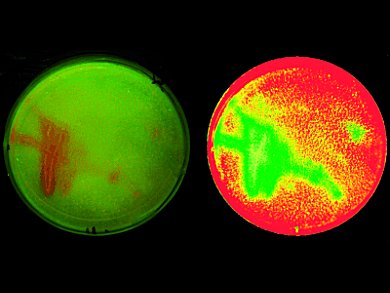Fluorescent pH-sensitive nanoparticles indicate bacterial growth
Rotting foods are a serious risk to our health. The food industry is therefore correspondingly strict in its vigilance toward bacteria in products. The influence of production and storage conditions on the growth of pathogens must constantly be evaluated. Researchers from Regensburg, Germany, have introduced a new method for monitoring the growth of bacteria: The fluorescence of nanoparticles embedded in an agarose growth medium changes significantly when the pH value changes because of bacterial metabolism. This can be monitored in real time with a simple digital camera.
Xu-dong Wang, Robert J. Meier, and Otto S. Wolfbeis from the University of Regensburg have developed a truly simple, broadly applicable process for the production of nanosensors for this purpose. A biocompatible polymer with water-friendly (hydrophilic) and water-repellent (hydrophobic) domains is added to water. If the concentration is right, the polymer forms stable micelles with relatively hydrophobic cores and a more hydrophilic outer layer. The researchers embedded two different fluorescent dyes in these micelles. The first is a hydrophobic fluorescein dye that gives of green light when excited by an LED, and is sensitive to changes in the pH value. The second dye exhibits red fluorescence that is independent of the pH value and thus acts as an internal reference. These nanosensors are mixed into a combination of agarose and nutrients commonly used for bacterial cultures. This mixture is poured into Petri dishes, where it forms a gel.
In the initial state, the pH is set so that the green dye does not fluoresce; only the red fluorescence of the reference can be seen. When a sample containing bacteria is added, they begin to multiply. Their metabolism causes the pH value of the medium to rise. As the pH value increases, the nanoparticles give off more green light, while the red fluorescence remains unchanged. The radiation can easily be detected with the red and green channels of modern digital cameras. The changes in the ratio of green to red fluorescence over time is recorded. This reflects the growth of the bacteria.
The nanoparticles are nontoxic and do not leave the agarose gel, so they are not taken up by the bacteria. They thus do not disrupt the growth of the bacteria, unlike some other sensors. The measurements are straightforward: Because it is only necessary to evaluate the ratio of the green fluorescence to the red reference, fluctuations in detection have no effect. By using conventional Petri dishes instead of small-format microtiter plates and imaging procedures instead of pH electrodes, it is also possible to resolve the spatial distribution of bacterial growth.
In the future, these new sensors could be integrated into food packaging along with a barcode to indicate the freshness of the food.
- Fluorescent pH-Sensitive Nanoparticles in an Agarose Matrix for Imaging of Bacterial Growth and Metabolism,
Xu-dong Wang, Robert J. Meier, Otto S. Wolfbeis,
Angew. Chem., Int. Ed. 2012.
DOI: 10.1002/anie.201205715


